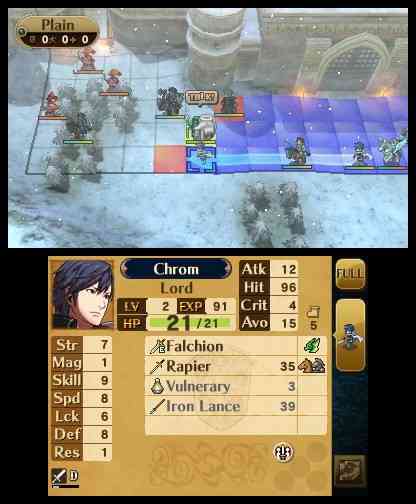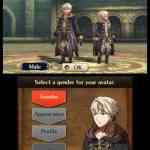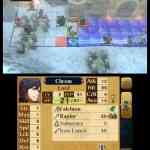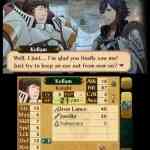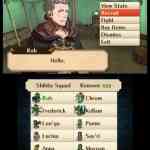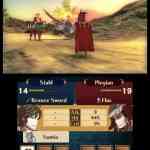Nintendo’s strategy RPG series Fire Emblem has one heck of a dedicated following. The game was first launched in Japan in 1990 on PC and the first console release was in 1994 on the Super Famicom. It has developed a very die-hard flock of fans throughout to globe. Strategy RPGs are a serious type of game too given that they require lots of thought, player management, and time to play, but that has not stopped this series from gaining the cult popularity it has. It has graced many Nintendo consoles since its inception and the last version released was on the Nintendo Wii in 2007 (not including Virtual Console versions of earlier games). Fans have been awaiting a new entry into the series, especially on the 3DS, and that time is almost here. At the time of writing this review, Fire Emblem: Awakening is about to hit North American stores and we have had the chance to play the final retail version. Reviewing this game was an interesting task for me as I am not a strategy RPG guru by any means, but Nintendo made sure that gamers like me can enjoy this game too.
The story in Fire Emblem: Awakening is a fairly good one. As would be expected in any RPG-like game you are battling evil and trying to make the world a better place. The story begins with you waking up while being eyed at by a band of soldiers known as the Shepherds, a group who protect the residents of the kingdom Ylisse. This kingdom has been the target of a group of bandits from another kingdom called Plegia. Plegia is looking to rage a war against Ylisse as payback for past behaviour committed against them. Confused yet? Well this is just the start and there is much more depth and story to be told here. New characters, new twists, there is a lot to take in. This is as good as my description of the games narrative is gonna get, but trust me, as you play the story unfolds in a manner that will keep you engaged wanting to see what happens next.
As with most games of this nature, your main gameplay experience is to move characters around a grid, find vantage points, and play a really grown-up game of paper, rock, scissors. The latter is done as you have various classes of weapons, with each being better then others. Different classes of soldiers hold these weapons of destruction. You can fight with archers, magic users, and armoured fighters. Each of these classes has attributes that will allow you to find something you like more then another. Such classes as the archer, who is known for his ranged attacks as well as his ability to strike down air units with greater success, are fun to use. Weapons and attacks also have stats attached to them allowing certain odds and/or percentages of attacks succeeding. Adding to the depth is that your AI teammates now can add such things as additional attacks, more protection, and stat boosts, as long as you are standing close enough to them at the time.
As I spent time with the Fire Emblem: Awakening the biggest thing that struck me is that it is truly a strategy RPG title, but it allows someone like me, who’s not a master at the genre, to enjoy the whole experience. Let me explain.
This latest entry into the series has a Casual Mode. In this mode, shoud one or more of your in game characters it is not a permanent thing. Once they run out of HP they are out of the battle but will return in the story once the battle sequences are complete. This is as opposed to the Classic Mode where if a character dies in battle, they are done for the rest of the game. The Casual Mode provides two main features. It allows the game a bit of ‘give’ as you are not punished if your player dies in battle. It also allows the games story to continue with all the characters, so you those less skilled at this genre (*ahem* like me) can enjoy all the story arcs that are highlighted between various characters. There is also a fairly good tutorial system for those not familiar with the series, or genre as a whole, but it can be turned off at any time. There are a total of four difficulties that you can play. Three are available from the get-go (Normal, Hard and Lunatic) and the fourth is unlockable (Lunatic Plus). I played on normal given my less then skilled approach.
For those who have played any of the games in this series, which can be a punishing, and who love the challenge it provides, don’t worry, the game is not dumbed down. Should you play the game in the Classic Mode you’ll have the traditional gameplay experience that you have loved since you first got hooked on it. Your decisions have an impact on the story that evolves in front of you. Should a specific character die while you are playing, the story changes and the world you play in changes along with it. Here the traditional Fire Emblem challenge and gameplay continues. So those veterans of the series can breathe a little more relaxed as the game can be played the way so many fans know how. Of course should you play on the harder difficulties while in Classic Mode then the challenge and experience becomes greater.
One of the neat things I found when playing was the ability to foster the relationships with all the other in-game characters. Early on in the game you are given the option in the menu screen to engage in conversations with other game characters (found under the “support” tab). These conversations become the basis of some of the story arcs, as well as foundation of building up your relationship between each other. It may sound somewhat corny, but I thought it was yet another layer of depth and gameplay experience that made Fire Emblem: Awakening such a good game.
Fire Emblem: Awakening is not a particularly linear experience. Although there is main storyline to follow, there are optional side quests and battles to spice things up. Side battles allow extra EXP for your characters that can make them stronger for future battles in the story while side missions have specific objectives that can result in rare items or new characters joining your party of heroes. You can also visit shops and engage in the aforementioned conversations with other in-game characters during play. There is a class system in Fire Emblem: Awakening too, and it is as deep as you can hope. Leveling up your class is not particularly difficult and if you should choose you can “reclass” with a special item resulting in some pretty wild results. For the die-hard strategy RPG fan, this is an area that will provide a lot of incentive for time and effort as the investment can result in some great classes of characters.
There is a multi-card local multiplayer mode included in this game. In theory this sounds great, but it is just two players engaging in battles together using three units from each of their teams. There is no story or objective mode here. SpotPass and StreetPass make a debut in Fire Emblem: Awakening too. SpotPass allows Nintendo to distribute some new content like free maps or characters. There is also planned DLC which will allow you to buy new content after release. StreetPass allows you to download data from others 3DS’s allowing for you to fight or hire characters (vial the data you downloaded) in your own game. I didn’t have the option to check out either the SpotPass or StreetPass features as the game was not in public release yet.
Visually speaking I have to say that I was caught off with just how good Fire Emblem: Awakening is. From the opening anime inspired scene to the gameplay itself, everything is solid. There are a lot of cutscenes that utilize Japanese animation along with a mix some CG scenes for good measure. Gameplay itself is a mix of 2D sprites and polygons that mix just right. I was amazed with how well all these styles make for a great presentation. As the story plays out a lot of the narrative (e.g. your interaction with characters) is presented with the aforementioned CG scenes, but with stills that have facial animations to go with the dialogues mood at the time. For those wondering, the 3D effect is quite well implemented as it give the scenes depth and special effects (e.g. ash or snow blowing along the screen) that add to the game being more then just a 2D image on the screen. It’s pretty neat to see.
Along with the games visuals, the audio is just as good. From the soundtrack to the voice acting that is included, everything just balances out so well in this area. Not all the dialogue is voiced, but there is a lot of voice work that has that typical Japanese feel to it. When you are reading the dialogue that is not voiced there is a fair amount of sound like harumphs, eeeshs, and other supporting voice sound to add to the feeling of the character’s mood or feelings at the time. Sound effects wrap up the whole audio package, from fireballs being launched, swords clashing against each other, to the sound of an arrow leaving the string of a bow.
As I first started playing Fire Emblem: Awakening, and being a rookie at this genre, I wondered what I had gotten into, but I can wholeheartedly say that this is one of the best games on the 3DS in quite sometime. The fact that it is a strategy RPG is what is even more amazing, as these types of games can be so daunting. This latest entry into the Fire Emblem series has the head banging, emotion stirring and deep gameplay of previous entries, but Nintendo has made sure to include some new options allowing so many other people to enjoy this series. Not to mention that the production values are pretty much second to none. This is one game that all 3DS owners should definitely consider, and for fans of the Fire Emblem series purchasing it is a no brainer as there is really not a lot to complain about here.
